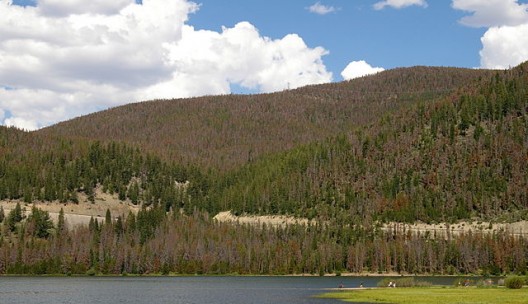Across western North America you can see them: hills blanketed with swaths of red and gray trees. These dead and dying stands of pine, aspen, and fir, totaling around 42 million acres—roughly the size of the state of Washington—are victims of bark beetles. And the dry, decaying trees that the beetles leave in their wake are not just eyesores; they also fuel hotter and larger wildfires. Now, recent research from the College of the Environment asks whether we could put beetle-killed trees to good use, extracting biofuel and other useful chemicals from their remains.

Due in part to climate change, naturally occurring bark beetles have reached epidemic infestations over the past twenty years, leaving land managers with a major problem: how to deal with all these dead trees. Currently, beetle-killed trees are removed by burning them on site. This practice results in the loss of the nutrients and other materials the trees are made of, and it contributes to air pollution. And using the infested trees as lumber is not an option, as beetle-killed trees rapidly degrade and discolor after they die. So College scientists are proposing a win-win solution: collecting beetle-killed trees for use in pyrolysis, a process of putting organic materials in a high-heat, no-oxygen chamber until they break down into useful extracts. If beetle-killed trees could be successfully used in this process, two issues could be addressed at once: the trees could render fuels and other chemicals, and their removal from the landscape would reduce the risk of catastrophic fires—an important goal in light of the more frequent fires that are also being driven by climate change.
To test whether lodgepole pine trees—one of the hardest-hit beetle-affected trees—could provide as many useful extracts as healthy felled lodgepole pines, Guanqun Luo and Fernando L.P. Resende, in the School of Environmental and Forest Sciences, subjected a sample of each to the hot, controlled environment that pyrolysis requires. When they compared the extracts they discovered that both beetle-killed and healthy pines provide similar amounts of alcohols, toluene, and other petrochemicals—extracts used for solvents, fuel, and as precursors to other products. This is an exciting finding, and the scientists urge more research into how this process could be scaled up, in particular by using mobile pyrolysis machines.
“Pyrolysis of beetle-killed trees in mobile units would convert very low-density wood into a higher density liquid product (bio-oil), substantially reducing transportation costs, which are a major barrier for the production of biofuels and biochemicals. We are now running tests with a pyrolysis unit in the lab that simulates conditions that would be found in mobile pyrolysis units in the field, and we are excited about the future possibilities,” Resende said.
The benefits of using pyrolysis that Resende and his lab have discovered, if used on the 158 million tons of available biomass of beetle-killed trees currently in the US, could produce millions of tons of valuable chemicals like toluene and xylenes, as well as upwards of 23 billion gallons of fuels—making up 17% of what the US currently consumes each year.
Read the scientific article by Luo and Resende, titled Fast pyrolysis of beetle-killed trees, in the Journal of Analytical and Applied Pyrolysis.
– Written by: Jen Davison

